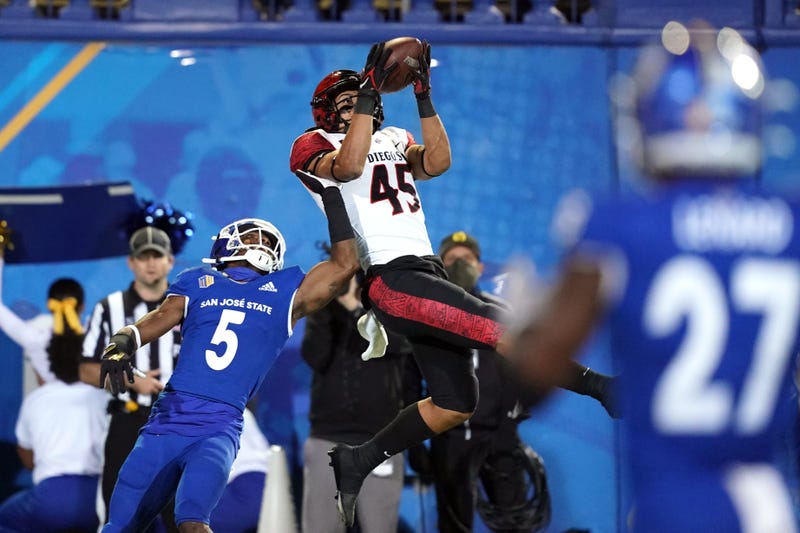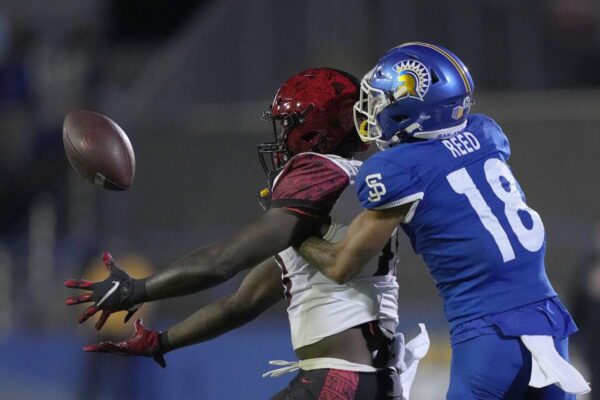Analysis of Aztecs’ victory over San Jose State

Credit: AP Photo

SDSU’s defensive front is so dominant. It often forces opposing teams to play outside their strengths. Offensively, in a day and age dominated by passing, the Aztecs have stubbornly stuck to the run game even in the face of defenses selling out to stop their ground attack each week. Friday night, the roles were reversed. San Jose State out “Azteced” the Aztecs.
“We have a lot of respect for their front – I have said that four times (in the press conference) – and thought we may have some problems,” Brady Hoke said post-game when asked why his team went away from their offensive identity Friday. “We were trying to get (SJSU) off the mark a little bit with changing up first and second down, throwing it a little bit more (to) maybe keep them in check a little bit.”
Game planning for the opposition’s strengths is the first job of any coach. It was surprising SDSU chose to counter what SJSU does best by going away from their own strength. Heading into the game, the Spartans had been average at stopping the run. Only once before Friday had they held an opponent under 100 yards rushing for a game. They were coming off a contest against Colorado State, where they gave up 217 yards on the ground.
San Jose State, in contrast, clearly has been a run-first team since Nick Nash took over as SJSU’s top signal-caller. They rushed over 30 times in their three previous games. Undeterred by the Aztecs’ stout run defense, the Spartans attacked SDSU on the ground 42 times on Friday. Taking a page straight out of the Aztecs playbook. The Spartans rushed 14 times in the first half for 30 yards, stuck with it, and gained 87 yards on 28 second-half carries. Even though the running game was not a tremendous success much of the night – they averaged 2.8 yards a carry, and their longest gain was only 16 yards – SJSU refused to acquiesce and change what they do best.
50/50 Balls
In the final analysis, Friday’s game came down to which team made the most plays on jump balls. While Nash may have gone to that well too many times, he can hardly be faulted for lofting the pass that Trenton Thompson intercepted in overtime. SJSU’s best offense throughout the night was Nash buying extra time, throwing up lollipop passes, and hoping his teammates would make the reception. After rewatching each of Nash’s 16 completions, 149 of his 229 passing yards came from 50/50 balls.
SDSU, in contrast, only was able to take advantage of jump balls a couple of times during regulation. When Jordon Brookshire threw passes in one on one situations, he typically threw them on a line, which requires a lot of timing and skill from everyone involved. One of the times he lofted the ball, Isaiah Richardson was able to adjust and make a 24 yard gain. In overtime, Lucas Johnson, of course, was successful twice. He allowed Jesse Matthews the opportunity to make a play on a ball and was rewarded with two scores.
In the future, look for the Aztecs to call for more of these types of plays. During scrimmages in fall camp, the offense’s best play was usually the 50/50 ball. These passes fit what SDSU’s quarterbacks should be able to do. They are all mobile and can improvise with their feet, much like Nash did Friday. With how teams are stacking the line of scrimmage against them, throwing jump balls into one on one coverage to Matthews, Tyrell Shavers, Daniel Bellinger, Richardson, or Elijah Kothe is a safe way to secure big plays.

“Jump ball, in man coverage,” SJSU head coach Brent Brennan said postgame. “In those moments, we got to make a play. It’s really a simple thing, and that’s the hard part of football. Right? (It comes down to) one play.”
Poll Watching
San Diego State continues to be a difficult team to assess because they do not fit the mold of a dominant team from the Group of Five. The Aztecs are 21st and 22nd in the coaches and AP polls, respectively. They trail SMU in both major polls, likely because the skill of the Mustangs is easier for voters to see and understand.
The polls are littered with numerous Power Five schools with average offenses but good defenses. Michigan, Michigan State, Penn State, Iowa, and Notre Dame have not been offensive juggernauts this season. They are ranked high, nonetheless, because voters know a good defense at those schools can take those teams far. UTSA, Coastal Carolina, and SMU are the ranked schools from outside the autonomous conferences, who are near SDSU in the polls. Each has had a close game similar to the Aztecs win over SJSU, but because they were higher scoring contests, they are not held against them as much.
Quick Takes
– There are a lot of very good defensive players on the Aztecs, but there is one star: defensive lineman Cameron Thomas. He finished with six tackles and two tackles for loss, including one sack. His play stands out in a defense with many stand-out players.
– Michael Shawcroft is shaking off rust from an early-season injury and showing what he can do when fully healthy. Eight tackles, three tackles for loss, a sack, and a forced fumble. There is an instinctiveness to his game that is special.
– Punching a ball out of your quarterback’s hands has to go down as one of the strangest fumbles. Chris Martinez’s forced fumble would have been a thing of beauty if he played defense.
– Early in the game, SJSU called a lot of curl routes, and easy type pass plays. SDSU called more difficult plays, including a play-action, roll out to Brookshire’s opposite hand on third and two. The trouble for the Aztecs is that completing short passes depends on accuracy, which Brookshire has lacked.
– Matt Araiza failed to record a tackle Friday. He joked postgame that his performance was “subpar” as a result.
– SDSU’s defense stunts their defensive line often. The tactic opened up holes for Nash to run at times.
– For all of Brookshire’s problems, throwing screen passes was not one of them. It continues to be something he does well.
– SDSU implemented some quick tempo to their offense.

– Sefo Mailangi is making plays. The defensive lineman used his experience to sniff out a play that had tons of misdirection to them.
– The starting average field position for each team was 24.42. That they finished tied to the hundredth decimal place was a coincidence of evolutionary significance.
– The Aztecs did not take advantage of Matt Araiza’s two huge punts. Both times he pinned SJSU deep, the Spartans responded with long drives.
– SJSU’s aim was to tighten the game by limiting the number of possessions. They were successful. Each team had only 11 legitimate drives in the game. 12 total if you include drives that ended the first and second half.
– No fan wants to hear that SDSU was actually successful moving the ball most of the night with Brookshire in the game, but the numbers bear it out. Only one of SDSU’s first seven possessions ended in a three and out. During that span, their drives ended at the SJSU 42, SDSU 43, SJSU 36, SJSU 48, SJSU 9, and SJSU 38. Despite gaining yards, the offense only managed six points.
– Near midfield, SDSU play selection was as follows: First Down- two run/four pass. Second Down- four run/two pass. Third Down- one run/four pass. Greg Bell only had one first down carry in that area of the field. Figuring out a way to get from midfield into the red zone will be a key going forward.
– Passing on first down left many third and long situations. SDSU had an average yard to gain of 8.7 yards on third downs on the evening. When SDSU had to pick up four or less yards, they only failed to convert once.
– Given Brookshire’s relative success, it clarifies why the coaching staff waited until ten minutes left to bring in Johnson. That they benefited from doing so was a mixture of luck and great defense.
– Teams have been attacking Trenton Thompson deep, and the team captain has responded well.
– One advantage SJSU had with committing penalties early in the game is when they suplexed Greg Bell twice after the whistle late in the fourth, the refs did not want to add to their substantial total.
– With the emergence of Patrick McMorris and the continued terrific play of Trenton Thompson, Cedarius Barfield’s play at the other safety position might be overlooked. It should not. He has filled that role well. Position coach Kyle Hoke deserves high marks for the production of his group this year.
– SDSU is 6-0 for the fifth time in their division one history.
[wpedon id=”49075″ align=”right”]
– How special was Friday’s victory? November 4, 2000, was the last time the Aztecs won on the road when rushing for 70 yards or less before their tussle with SJSU.
– San Diego State was outgained by 105 yards. However, matt Araiza nearly gained all of that back. SJSU and SDSU each had seven punts, but the Aztecs gained 91 yards of field position on their kicks.
– None of Araiza’s seven punts were returned.
Half way through a normal FBS season, Matt Araiza has:
– 25 50-yard punts (NCAA record is 32)
– 12 60-yard punts (NCAA record is 14)
– 4 70-yard punts
– 1 80-yard punt (86)— Jamie McConeghy (@McConeghySDSU) October 18, 2021
My earliest sport’s memory involve tailgating at the Murph, running down the circular exit ramps, and seeing the Padres, Chargers and Aztecs play. As a second generation Aztec, I am passionate about all things SDSU. Other interests include raising my four children, being a great husband and teaching high school.